School Standards and Designs Advance
New techniques support Common Core, and more
![]() Continuing Education
Continuing Education
Use the following learning objectives to focus your study while reading this month’s Continuing Education article.
Learning Objectives - After reading this article, you will be able to:
- Discuss the implications of new state educational standards including Common Core on today’s school environments.
- Describe how the increased use of technology and collaborative learning environments affects school building interiors designs, layouts, and specifications.
- Identify sustainable and resilient design techniques that provide life-cycle benefits for school renovation and new construction projects, such as enhanced durability.
- Explain how such design variables as daylight, lighting, and color can contribute to both improved energy efficiency and better student performance.
The controversial rollout of the Common Core State Standards for public K-12 schools in 45 states has elevated the discussion of what tomorrow's schools will look like and how they will work. In recent months, critics have complained that the national standards for English language arts and mathematics could restrict teaching options and place undue pressure on students by demanding too much new testing. Yet the new curricula and teaching approaches are seen as instilling critical thinking skills in young students by using classroom setups and technology that prepare them better for college and employment.
Architects and their clients have seized upon the Common Core standards to consider new ways to build creative, effective learning environments. These will propagate, too: According to the National Governors Association and the Council of Chief State School Officers, the Common Core State Standards (CCSS) facilitate sharing between states on new policies and teaching tools, including:
- New textbooks and digital media aligned to the standards.
- Comprehensive annual assessment systems to measure student performance.
- Changes needed to support educators and schools in teaching to the CCSS.
That third, vague mandate for “changes” is where new facility designs enter the picture. According to the Association of American Educators (AAE), “In recognizing their unique design, there are certain changes that should be happening in the classroom as a result of Common Core.”1 (See sidebar “Building for the Common Core” on page 8.) The new schools and reconfigured learning environments are language-rich, highly engaging, and collaborative, encouraging deeper use of technology and, ultimately, understanding beyond memorization.
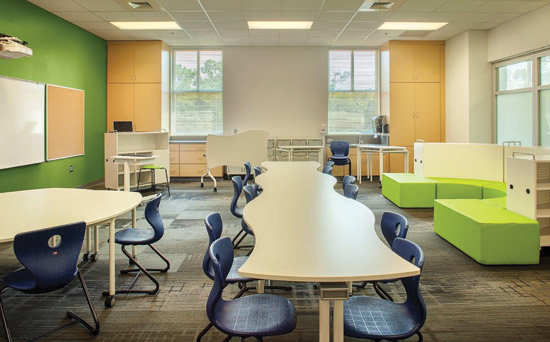 |
For collaborative, project-based learning, Clarke County schools introduced opening glass walls, flip-top tables and stacking desks on casters, adaptable storage modules, moveable soft furnishings, and low partitions, among other innovations. Photo courtesy of VS America, Inc. |
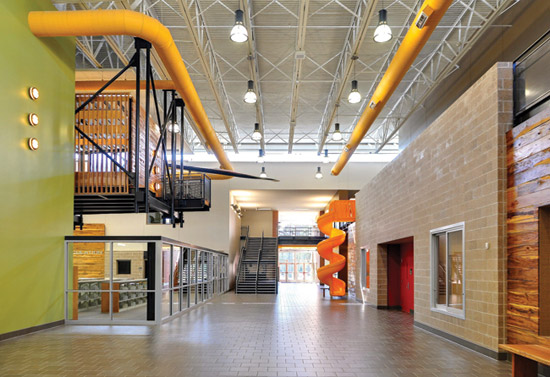 |
Geothermal and building-based heat pumps are used in schools like Gloria Marshall Elementary School in Texas to move energy or heat from unoccupied building areas to zones where heat is needed. Photo courtesy of ClimateMaster |
Building Creative, Effective Learning Environments
There are several overarching needs for today's K-12 schools that are seen as essential for supporting student and teacher needs as well as new instructional methods.
 |
School spaces and learning are more flexible, making operable interior glass partitions a helpful approach for converting classrooms “on the fly” from traditional lecture setups to group learning, as well as moveable walls and flex-spaces to increase or decrease room size or allow for multiple uses. Photo courtesy of Space Plus |
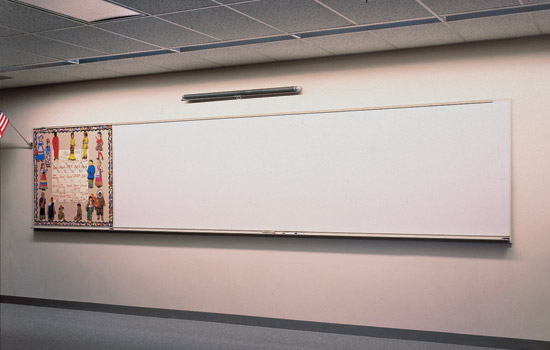 |
Continuous wall-wash fixtures specified by Greer S.J.C.F. for Derby High School in Derby, Kansas, illuminate the school’s whiteboards and ensure consistent luminance levels within a 3-to-1 ratio between visual tasks at the desk and the front of the room. Photo by Ric Wolford, Douglas Photographic Imaging, courtesy of ELP |
Flexibility
“School spaces and learning are more flexible today,” says Sheryl Hai-Ami, president of Space Plus, which makes operable interior glass partitions for schools and other end users. These include converting classrooms “on the fly” from traditional lecture setups to group learning, as well as moveable walls and flex-spaces to increase or decrease room size or allow for multiple uses. “Also, teachers and administrators are moving from isolated functions into more flexible teams, with more need for common areas and open environments with multiple configurations,” says Hai-Ami.
This thinking about adaptability and reconfigurability has seeped into the design of all building systems—even heating, ventilation and air-conditioning (HVAC)—that better reflect school use patterns, says Tony Landers, a mechanical engineer and director of marketing for ClimateMaster, which makes water-source heat pumps. “Increasingly, geothermal and building-based heat pumps are being used to reduce operating costs, because the systems can move energy or heat from one building area or room that's not occupied to another where the heat is needed,” says Landers. “Some systems can also free up space on the grounds or rooftops, since fewer units may be needed.”
The result is a more efficient school building that also flexes according to the curricular needs of Common Core standards and other new educational trends.
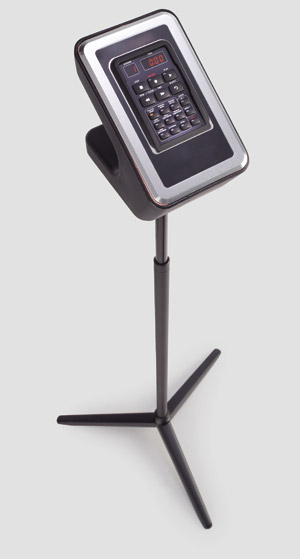 |
“Virtual acoustic environment” systems allow schools to customize the acoustics of their music rehearsal spaces by adjusting the panels as needed to act as diffusers or absorbers. Photo courtesy of Wenger Corporation |
Technology
The use of technology also affects school planning, floor layouts, and even furniture designs, says Carmen Klaus, business development manager with school furniture and ergonomics company VS America, Inc. “Being untethered is vital to the classroom of the future, and technology is changing so fast that some desks and tables that incorporate technology directly may be outdated in a few years,” she explains. “We've also seen a number of media-geared furnishings with integral displays and cords for attaching tablets and laptops directly, but these permanently tether the students, limit the number of participants to the number of connections, and some have become so heavy they can't easily be moved. That's why we're introducing completely new and untethered concepts.”
According to AAE, Common Core schools demand more integration of technology and learning, as students are required to communicate and collaborate with others using Twitter, blogs, web services like Google docs, and new hardware such as smartphones, tablet computers, and Internet-based laptops such as Chromebooks.
With this in mind, the future of U.S. education will include more wireless setups and furnishings that can be moved from room to room, including classrooms with video screens, online education, and distance learning, says Lee Hedberg, director of engineering for Engineered Lighting Products (ELP), a commercial lighting specialist. “These projectors and new multimedia tools help with the transmission and receiving of information, but they make lighting in the classroom a real challenge,” he says. “Architects are assessing the various functions of learning spaces and how to adjust lighting for the use of smart whiteboards, for example, when they are both in use and powered down.”
These variables—along with new teaching modalities—add complexity in designing not only lighting systems but also classrooms that have never been seen before. Other specialized design needs include renovating and retrofitting school areas for arts, music, and other non-technology uses. “Proper acoustics for music rehearsal spaces is increasingly a challenge for schools now that the rooms are being used for various groups, not just band, orchestra, and choral uses,” says Ron Freiheit, director of design engineering for Wenger Corporation in Owatonna, Minnesota. “There are new products that allow these spaces to be more flexible, including wall panels that convert from absorbers to diffusers, as needed, and digital sound systems.”
Durability
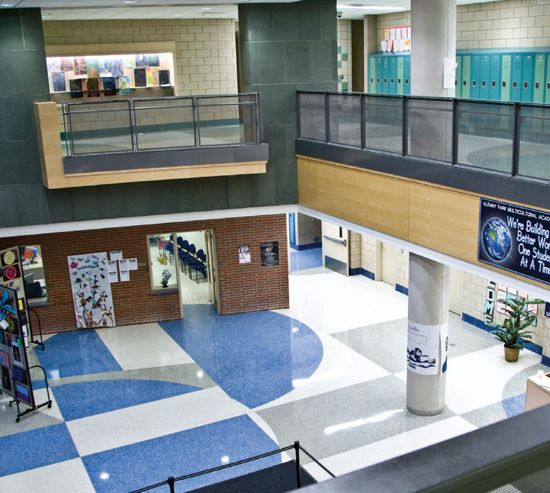 |
The durability of terrazzo has made the material a favored specification for LEED-rated school buildings, such as the Albany Park Middle School in Chicago, designed by Cannon Design and certified as a LEED for New Construction project. Photo courtesy of The National Terrazzo & Mosaic Association, Inc. |
Underlying the new teaching tools and facilities is a built infrastructure that addresses basic issues of durability, life cycle, and resilience. For example, a multipurpose room that supports frequent reconfigurations and heavy traffic may require wainscoting, rail guards, and corner guards, as well as a long-lasting floor material such as terrazzo.
“When bond issues are passed, school districts are very closely evaluating the long-term use of the facility,” says Richard Bruns, executive director of The National Terrazzo & Mosaic Association, Inc. (NTMA), a trade group based in Fredericksburg, Texas. “A lot of folks demand a greater life expectancy of the facility itself, and choices such as terrazzo floors are good for 30 years with minimal maintenance.” Other durable products are also gaining traction, say architects.
In fact, a renewed focus on durability is one of the surprises of the latest wave of school design, says Deborah Ruriani, manager of projects and construction business with Miele Professional, which manufactures commercial laundry and dishwasher systems as well as laboratory glassware washers for school laboratories, gymnasiums, cafeterias, and other uses. “Architects and school districts are working to identify the sustainability features, end-user advantages, and life-cycle cost benefits of using premium fixtures and systems,” says Ruriani. “The increased focus on science, technology, engineering, and mathematics or STEM programs has helped curtail the long-held practice of choosing cheap, sometimes substandard machines simply because they are the least-cost option.”
The same is true in the design of frequently used areas such as entryways or places where safety over time is a prime specification criterion, according to Jeff Baker, assistant general manager of SlipNOT® Metal Safety Flooring, which makes slip-resistant floor components such as plates, grating, stair treads, plank, and ladder rungs. “Schools are trying to eliminate slip-and-fall hazards while still maintaining compliance with the Americans with Disabilities Act,” or ADA, Baker explains. “Using abrasive metal surfaces, schools have long-lasting, low-maintenance pedestrian areas that meet regulatory standards for the minimum required coefficient of friction.”
Inspiration
Another aspect of newer school designs—whether they are designed for Common Core standards or other pedagogical needs—is the interest in introducing more color, daylight, plantings, and other ways to stimulate visual interest and provide positive distraction. According to the Clinical Solutions & Research team of the architecture firm HKS, a positive distraction is any environmental feature that both “holds attention without stressing the occupant” and “elicits positive feelings.” The main goal? Stimulating, engaging, and inspiring students to work more productively and creatively.
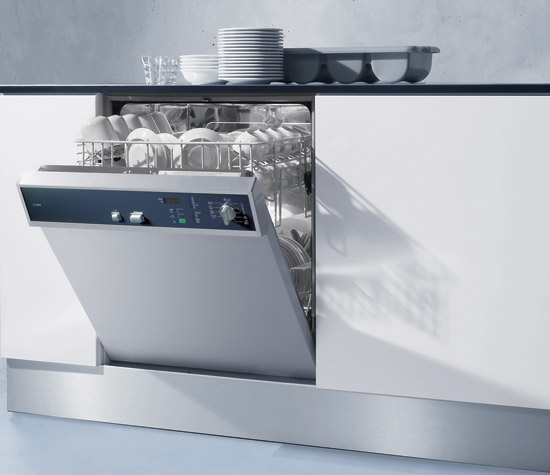 |
Schools often have special requirements such as ADA-compliant and NSF ANSI 3-approved equipment and look for durable products with longer life cycles. Photo courtesy of Miele Professional |
“The adaptation of bold, bright color palettes, especially for elementary schools, seems almost a requirement for school architecture now, based on interest we see from designers,” says Michael Cobb, a construction industry veteran and vice president of sales and marketing for Nichiha USA, Inc., which manufactures fiber-cement cladding. “There is increased interest in custom colors that serve the psychological aspect of environmental design, and recent studies show how various hues create an environment for learning or playing, and how they can be used to further that intention.” In a related trend, Cobb adds, some K-12 facilities are built with product finishes that match their school colors.
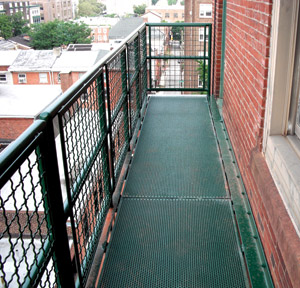 |
Architects specify slip-resistant metal floor components to eliminate hazards while still complying with ADA or OSHA requirements. Photo courtesy of SlipNOT® Metal Safety Flooring |
Like color, daylight and views to the outdoors are seen as conducive to better student performance. In addition to the classic 1999 Heschong-Mahone study that linked natural light with improved test scores, a 2003 study for the California Energy Commission2 concluded that “student performance was higher in classrooms with a better, primarily larger, view to outdoors,” according to Lawrence Berkeley National Laboratory's Indoor Environment Group.
Though not universally considered conclusive, these findings are leading to more architectural transparency and such solutions as increased use of fire-rated glazing in place of what have traditionally been opaque fire-rated separations. Not only do these glass walls invite more daylight into learning areas, they also improve visibility and safety, says Ken James, past president of the GANA fire-rated glazing council and sales and product manager for AGC Glass Company North America. “Glass wall products in entrance and egress areas, and their growing application to stairwells that traditionally are cinderblock walls, allow teachers and administrators increased visibility in stairwells and vestibules for the purpose of monitoring student activity,” says James. “This results in a safer environment for the students and staff members.”
James says that to design such applications, architects should carefully understand the differences between fire-resistive and fire-protective glass products and assemblies, including glazing and spacer requirements for insulated glass units (IGUs) and monolithic glazing. Fire-protective glazing is designed to contain fire, flames, and smoke to compartmentalize the building and keep the fire from spreading; fire-resistive glazing is also able to resist the transfer of heat through it. In the standard fire test, an assembly subject to 1,200°F fire for 10 minutes must allow a heat increase to the other side of the assembly of no more than 250°F above ambient temperature.
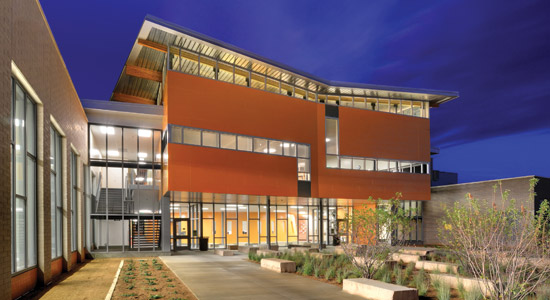 |
Bold, bright color palettes in elementary schools, such as these fiber-cement cladding panels on Red Hawk Elementary School, serve a psychological aspect of environmental design shown in recent studies to create an environment for learning or playing. Photo courtesy of Nichiha USA, Inc. |
Collaboration
Last, the Common Core standards also require the use of multiple learning methods and teaching modalities, not just the “sit and get” layouts associated with traditional lecture delivery. In particular, the Common Core favors collaborative learning techniques and student teamwork in addition to one-to-one and one-to-all instruction. “The key is to have both a collaborative product—to grade them on collaboration—and an individual product that holds students accountable to the other Common Core Standard,” according to Andrew Miller, an educational consultant.3 “Just remember you must teach your students how to collaborate before you can assess how well they do collaborate. This is good practice.”
In practice, the need for collaborative learning implies either schools with shared spaces that allow for team-based work or learning environments with convertible furnishings, partitions, and openings. (They could also have a mix of the two.)
Flexible and Untethered
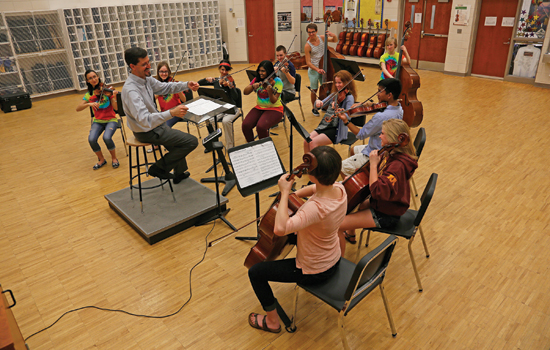 |
To improve acoustics in a rehearsal room at Wayzata High School in Minnesota, the school installed a specialized digital rehearsal system that allows the music instructors to control the settings to simulate various acoustical environments. Photo courtesy of Wenger Corporation |
The idea of introducing “flexibility and untethered technology throughout a K-12 school facility” is one way to provide a collaborative learning platform, says VS America's Klaus, pointing to the “amazing work of project teams” like those at the Clarke County School District in Athens, Georgia, led by David A. Stubbs II, director of facilities planning and construction.
In a recent presentation to the Council of Educational Facility Planners International (CEFPI)4, Stubbs described the overarching aim of the district's project—to give students and teachers the tools they need as a palette and blank canvas, so they can be used as needed. The three main goals include:
• “Integrating untethered technology into a learning environment [to] allow increased flexibility in a learning space,” including the use of technology-enabled active learning, or TEAL, which is more common in higher-education settings.
• Using “elegant simplicity” to provide “multifunctional designs in a classroom to enhance the usefulness of a learning space.”
• Employing more “baseline effective designs [that] respond and adapt to multiple learning and teaching styles.”
The schools were interested in supporting both collaborative project-based learning as well as problem-based learning, which “simultaneously develops both problem-solving strategies and disciplinary knowledge bases and skills...by placing students in the active role of problem-solver confronted with an ill-structured problem that mirrors real-world problems,” according to the researchers Finkle and Torp.5 Some of the changes included using a flipped classroom, defined as putting the onus on the student to learn concepts first, such as through homework, and then to hone their knowledge in the classroom—the opposite of a traditional model.
For the Clarke County schools, the new designs introduced opening glass walls, flip-top tables and stacking desks on casters, adaptable storage modules, moveable soft furnishings, and low partitions, among other innovations. “The shapes all pair together, and 140 classrooms in this district, and there's no two that are the same,” says Stubbs. Curves, colors, and figurative motifs were applied to formerly bland surfaces, with new nooks for study alone or collaborative work. Varied lighting schemes mix pendants, recessed fixtures, and focal points. Essential to the new learning spaces were the new desks, chairs, and TEAL furnishings: “When I hear the word adaptable, words like interchangeable and reconfigurable come to mind. Furniture must easily nest and pair into a multitude of configurations,” says Stubbs. “And it's working: We are seeing 100 percent engagement of students because we allow them the opportunities to decide how they want to learn.”
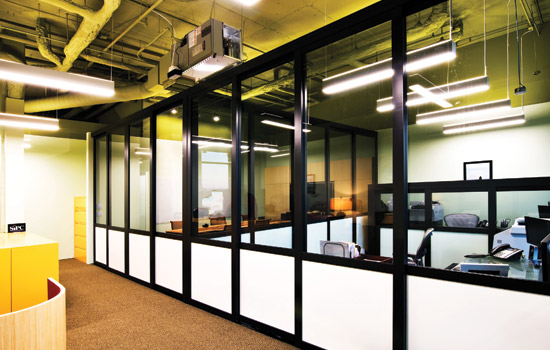 |
Opening glass walls and retractable partitions help make educational spaces flexible and integral to the school’s instructional vision, as applied to this school in Seattle. Photo courtesy of Space Plus |
Opening glass walls and retractable partitions were also essential to making the spaces highly flexible and integral to the school's instructional vision—an approach that is seen more frequently in a range of educational spaces.
Common needs include separating a flexible classroom from a collaborative discussion space so that students can brainstorm ideas together, and the ability to hide displays and whiteboards when they are not in use. Examples are everywhere, says Hai-Ami of Space Plus, such as the recent renovation at California State University, Long Beach, where new frosted-glass partitions with whiteboards were added for visual privacy while also enhancing student collaboration. For another educational renovation in Galveston, Texas, sliding glass walls were added by the architect PGAL in Houston, to cover a whiteboard that could carry confidential messages or the answers to a pop quiz.
Less common but growing in appeal are specialized techniques for increasing the adaptability of art, music, and special-purpose rooms to allow for an expanded curriculum or broader use. At Wayzata High School in Plymouth, Minnesota, for example, the music program required a better rehearsal facility so that the band, orchestra, and other music groups would have proper acoustics and a way to simulate the specific acoustics of various performance settings. Mark Gitch, the school's director of orchestras, considered the retrofit of a digital acoustical rehearsal system including a central processor and wall- and ceiling-mounted speakers.
After upgrading the music rehearsal space, Gitch can now simulate the Wayzata High School auditorium and nine other preset acoustical settings that replicate performance venues. “We had a good rehearsal space, even before the rehearsal system was installed,” Gitch says. “Now when we're physically rehearsing in our orchestra room, we can feel like we're really rehearsing on our stage or we can choose an acoustically drier environment if we like. The system gives us many options.”
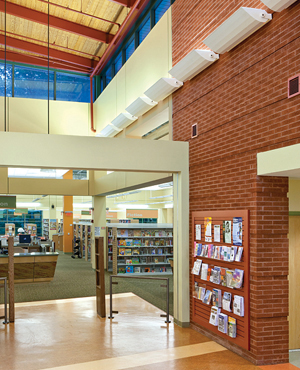 |
Oakton Library in Oakton, Virginia, is a LEED Silver facility designed by PSA Dewberry, utilizing natural light from clerestories at the entry, which is supplemented with indirect uplighting for evening or cloudy days. Photo courtesy of ELP |
Tradeoffs Benefit Energy Use
Clearly, the idea of a more flexible and adaptable K-12 environment is supported by a variety of products and technologies, from the architectural to the ergonomic to the digital. Yet cost and maintenance are as critical to product selection as innovation is. Schools are often compelled to procure the least-cost solutions rather than those that are best able to support the Common Core standards or other education initiatives. In addition, multiple regulatory regimes require school districts to adhere to such mandates as building codes, energy standards, ADA accommodations, union rules, and OSHA safety statutes.
“School lighting is subject to state energy codes such as Title 24 in California and in other jurisdictions by the International Energy Conservation Code and the ASHRAE/IESNA standard 90.1, which limit watt per square foot, also known as lighting power densities or LPDs,” says ELP's Hedberg. While the energy codes provide reasonable limits on lighting energy used, they also challenge the design team to employ daylight and dimming controls as well as zone-based lighting with occupancy sensors, and a large variety of fixtures for special needs. “Yet you have to make the system very simple for easy operations at a K-12 school,” adds Hedberg.
At the Derby High School in Derby, Kansas, the specifier Greer Stafford / S.J.C.F. dealt with a challenging condition for marker boards in classrooms where eyestrain and whiteboard reflective glare are often issues. The firm used linear wall-wash fixtures mounted end to end to ensure consistent luminance levels within a 3-to-1 ratio from one visual task to another, such as looking from notes on a desk surface up to the board at the front of the class. In another case, the LEED Silver-certified Oakton Library in Fairfax County, Virginia, uses high levels of natural light and uplighting from wall-mounted overhead fixtures to reflect light into the library aisles.
 |
For the LEED Gold Gloria Marshall Elementary School, architects at SHW Group incorporated an on-site wind turbine and 10 kilowatts of roof-mounted photovoltaic cells in addition to a geothermal heating and cooling system. Photo courtesy of ClimateMaster |
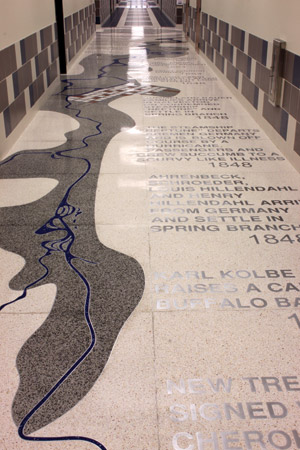 |
At Houston’s Spring Branch Elementary School, a terrazzo floor shows a timeline along the Buffalo Bayou for the movement of settlers. Photo courtesy of The National Terrazzo & Mosaic Association, Inc. |
According to Fairfax County officials, the Oakton facility cuts energy bills by 26 percent as “compared to a traditionally built library branch … producing a savings of about $10,000 per year.” The savings come from maximizing natural light through seven oversized windows and a raised clerestory, but also by using sensors to automatically dim the lights to the greatest degree possible.6
Energy savings—and the associated budgetary benefits—are also driving the use of geothermal energy and other low-cost and renewable energy sources, according to ClimateMaster's Landers. As a recent example, he points to the Spring Independent School District (ISD) in Texas, which achieved LEED Gold at Gloria Marshall Elementary School, a new facility completed last year. Architects at SHW Group and Spring ISD administrators conceived the two-story, 105,000-square-foot building with an on-site wind turbine and 10 kilowatts of roof-mounted photovoltaic cells. Passive solar features and a reflective white roof also reduce cooling loads.
A 275-ton geothermal-based HVAC system was also included to boost the renewable energy profile and energy-efficient design, estimated at about 25 percent better than that specified by code. A network of 180 vertical wells, bored about 300 feet underground, provide geothermal heating and cooling—a first in the Houston area, according to Mark Seibert, principal at CMTA Consulting Engineers. It is also one of many built elements integral to the school's successful pedagogical approach called discovery learning, says Kathy Morrison, principal of Gloria Marshall, a technique of inquiry-based instruction that originated in the 1960s and allows students to use problem-solving and experimentation to “discover” answers.
“Everywhere you look there are teaching tools incorporated into the campus. In fact, the building itself is a teaching tool,” Morrison says. “Using discovery learning, our students are involved in engaging projects that incorporate core subjects and have been designed with the learner in mind.”
More Durable and Resilient
Other changes to architectural design are focused on the challenges of reducing maintenance and improving serviceability while also shoring up the facilities against frequent reconfigurations of interior spaces, long-term abuse challenges, and even severe weather events.
Many of these perennial issues are seeing subtle changes with the advent of new teaching techniques, according to NTMA's Bruns, such as the increased benefit of terrazzo in areas where classroom furnishings, moveable walls, and sliding doors can scuff and scratch softer floor materials. “In terms of ongoing maintenance and labor costs, terrazzo is among the easiest to maintain,” says Bruns. “And when there is a need to renovate or retrofit, if there is existing terrazzo the schools only need to refinish and reseal the existing terrazzo to bring up the luster and gloss. In some cases, the architect will specify pouring additional terrazzo where walls have been moved, adding new colors or accent features to fill in the floor.”
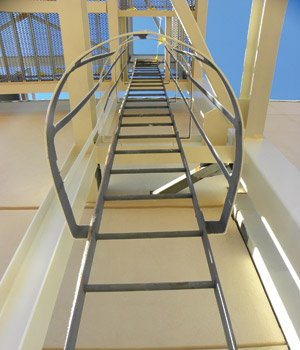 |
For schools like Valley View Elementary in York, Pennsylvania, some renovations include nonslip aluminum ladder rungs, especially in areas that may become slippery, even when maintained carefully. Photo courtesy of SlipNOT® Metal Safety Flooring |
In many school districts, however, damage from recent storms such as Hurricane Sandy in the northeast and Katrina in the Gulf region have led to more careful specifications to limit losses due to flooding, high winds, and projectiles. At the Central Intermediate School in Ottawa, Illinois, for example, rains related to Hurricane Ike filled the Illinois River to overflowing in 2008, causing flooding inside the one-story, 90,000-square-foot structure. Boilers, insulation, wiring, furniture, and doors—many still intact and original to the 1947 building—were destroyed by the deep inundation. Original asbestos tiles were also detached from the floors, but the original terrazzo floors in the corridors were unaffected even though they were underwater for an extended period. Educators and architects took note: In some cases, the life-cycle benefits outweigh an initial cost premium.
“Often the schools affected by storms and flooding are not adequately prepared or budgeted to make repairs,” says Andrew Franz, AIA, principal of New York City-based Andrew Franz Architect. “Working with Architecture for Humanity, we recently met with the principal and staff of PS 329-Surfside in New York and local families on a community design charrette. The goals was to design new sports and active learning spaces that not only meet their vision but also that are resilient enough to withstand water damage and minimize repairs.”
A related example is the use of inherently slip-resistant materials in places where they have not traditionally been required or instead of applied protective coverings, such as doormats. The benefits run the gamut from lower accident rates and reduced liability to fewer absences and insurance claims for students, staff, and teachers. According to the Bureau of Labor Statistics, injuries from slips, trips and falls number about 226,000 incidents across the country.
At Valley View Elementary in York, Pennsylvania, for example, recently made strategic upgrades to the school were designed to improve safety. As seen in the 290-student school's strategic plan, attention to the needs of the most at-risk students is a core tenet of its culture supportive of learning, as is the development of differentiated instruction methods for its new mathematics program. To keep staff and teachers safe, the renovation completed in 2011 included non-slip aluminum ladder rungs for mezzanine access in the school's kitchen and mechanical room. Both areas quickly become slippery due to dust, grease, and other substances, even when maintained carefully. Valley View Elementary selected a product designed to maximize traction in these slippery conditions.
The simple fix specified 24 custom aluminum tube sections coated in Grade 2 aluminum slip-resistant surface to match the ladder design. The aluminum alloy will not have the rust and corrosion concerns associated with steel alloys while the patented, hardened coating provides a coefficient of friction of at least 0.85, where greater than 0.6 is considered safe and less than 0.4 presents a dangerous condition. According to OSHA, fixed metal ladders should be “corrugated, knurled, dimpled, coated with skid-resistant material, or otherwise treated to minimize slipping.” OSHA also recommends a static coefficient of friction of at least 0.5 for walking surfaces, though the ADA Access Board has recommended a higher coefficient of friction of 0.6 for accessible routes and 0.8 for ramps. With this in mind, metal safety flooring is used increasingly in such educational settings as parking garages, performing art centers, pedestrian walkways, and at building entrances.
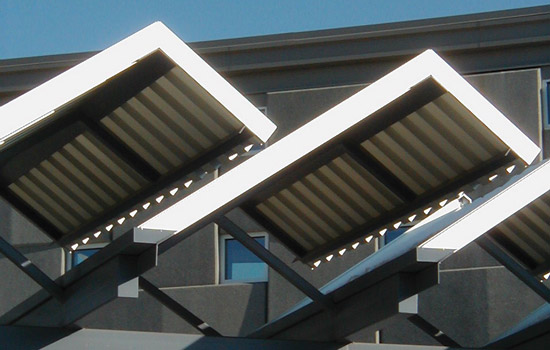 |
In this new renovation and addition designed by The Adams Group for the Garinger High School, new laboratory glassware washers were specified and installed. Photo courtesy of The Adams Group |
Long-Lasting Purchases
Treated metals using the anti-slip, primarily martensitic steel surface coverings or other random-hatch matrix substrates are also very durable and tend to last a long time with little maintenance. This quality is also being emulated in other procurement choices by school districts in recent years, as localities passing new school construction bond issues or capital project referenda seek to maximize their value, say observers like NTMA's Bruns and Miele Professional's Ruriani.
“Once the construction budget is depleted, schools rarely get enough money to repurchase products, and it is much too hard to get financing,” Ruriani explains. “Architects and project teams today are reviewing equipment specifications to identify their life-cycle benefits and return on investment or ROI over the long term—not just the price tag to purchase.” This is true of dishwashers used for special education rooms and science laboratory glassware washers: the appliances must be safe, easy-to-use, and automated whether to clean beakers and test tubes or simply lunch dishes.
With an increased focus on STEM programs at many schools, the investment in long-lasting lab equipment with a 10- to 20-year lifespan (about 15,000 operating hours) is seen as the baseline. Related benefits, such as water and energy savings, recyclability, and long-term cost advantages, help make the case for ROI.
This was true at the recent renovation of the 1957 Garinger High School in Charlotte, North Carolina, a modernist building originally designed by architect A.G. Odell, Jr., to fulfill city school superintendent Elmer Garinger's belief that nontraditional architecture could “stimulate student learning.” The updates by Adams Group Architects added a new student lobby and administration building as the firm reworked the school's media center and refurbished the auditorium “to foster the predominant features of the existing campus while adding new functional and visual qualities.” New lab glassware washers and other equipment types were also installed.
Unequivocally Fun and Functional
As Garinger anticipated with the design of the original high school campus—a historic landmark with its courtyard design showcased in National Geographic in 1962—Adams Group could use a variety of techniques not simply to make the school more functional but to enliven and enhance the student experience to spark deeper learning. “Each classroom group or pod is multidisciplinary, like a school within a school, almost a standalone high school, and we've continued that today because it is still a current theme today,” says Graham Adams, AIA. The firm added engaging shapes like new multicolored precast concrete panels in a weave pattern as well as a new, deep blue entrance floor echoing the original precast patterns, and a bright yellow feature wall punched with rectangular windows.
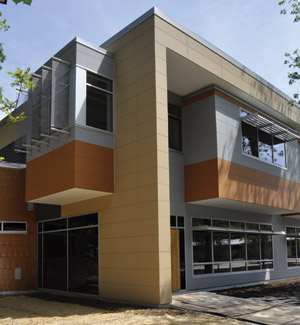 |
Bold, bright color palettes in elementary schools, such as these fiber-cement cladding panels on Red Hawk Elementary School, serve a psychological aspect of environmental design shown in recent studies to create an environment for learning or playing. Photo courtesy of Nichiha USA, Inc. |
These colorful planes and patterned surfaces are inviting and stimulating, says Nichiha's Cobb, pointing to new studies on how colors create an environment for learning, creating, working, and playing. According to Pam Maynard, AIA, CID of HMC Architects, a seminal study by Richard Koller in 1976 used electrocardiogram (EKG) readings showing that human heart rates are slower in more colorful rooms, and faster in gray rooms. “A dull environment leads us to turn to our inner self, showing symptoms of restlessness, irritation, and difficulty in concentration,” says Maynard, while “a white or neutral environment does not provide a neutral effect on the user.”
That's why the new Goodwin College Early Childhood Magnet School and others are using color as an organizing tool and step toward self-direction. Visual themes in the interior finishes and architecturally integrated artwork, a specialty of the project's architect, Svigals + Partners, include floor tiles in earth tones of blue, green, orange, and yellow that lead children in the direction of corresponding color-coded pods. The strategy that instills a sense of continuity and independence in young children by helping them avoid becoming lost. Likewise, rectangular plaques with one of four leaf patterns adorn the walls, providing another visual cue for orientation, as each leaf tree species corresponds to one of the four pods.
An example of the more audacious effects of color can be found in the high-performance addition to St. Francis High School in Wheaton, Illinois, designed by Serena Sturm Architects of Chicago and the architect-academic Keelan Kaiser, AIA. The new science and learning center consumes about one-third of the energy of a typical high school, with its “well-insulated building envelope, passive design, and high-performance mechanical systems” now tracking a rarity for high schools: LEED Platinum, according to Kaiser.7
 |
Whiteboard lighting is one of the primary challenges of designing effective illumination in today’s technology-focused classrooms with multimedia tools. Photo courtesy of ELP |
Yet students won't immediately notice the sustainable qualities of the building. Instead, they will see the wide bands and scattered panels of bright orange, as well as a rounded projection, finished almost entirely in orange and punched with horizontal slit windows. Most of the new facility's exterior is clad in vibrant fiber-cement panels with a concealed fastener system and a backdrained, ventilated rainscreen. Further animating the composition are shading canopies and cantilevers to block the sun. Yet a walk through the new science center proves that ample daylight enters the spaces, such as the physics lab with its wide skylights.
As at the Wheaton prep school, other K-12 projects around the country are taking care to increase the amount of available daylight indoors. An important strategy is to open up interior walls with fire-rated glazing and framing products, which now allow increased freedom for architects, such as the construction of 60-minute-rated, butt-glazed glass separations. This type of assembly has been used at a number of schools including at the stairwell landings at the Houston Independent School District's new administration building and the mezzanine of the Lorry I. Lokey Graduate School of Business at Mills College in Oakland, California.
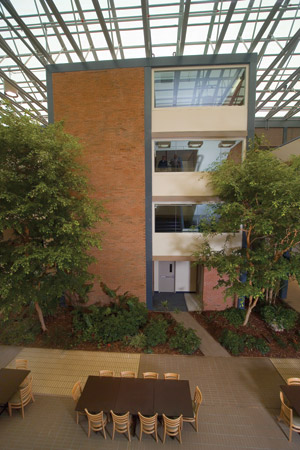 |
Fire-resistive glass vision systems are being utilized effectively to block flames, smoke, and radiant heat for up to 2 hours, in lieu of traditional opaque walls or glass block. Photo courtesy of AGC Glass Company North America |
“Depending on the local codes, when the glass area is 25 percent or greater of the fire-rated separation, it is no longer considered an opening,” says AGC Glass' James. “At that point it becomes a 'wall application' that has to perform like a fire-rated wall and hold back smoke, flames, and heat.” These specialized assemblies include glass with intumescent interlayers that dissipate or block the heat: When temperatures reach a certain level, the clear glass product becomes opaque to help block heat and flames. Fire officials also contend that by turning the glass walls opaque, it also helps reduce panic during fire emergencies.
Detailing of these separations is critical to proper performance, adds James. For example, while aluminum spacers are commonly used in insulated glass units, fire-rated IGUs require stainless steel spacers, and a secondary silicone seal to be listed by UL, or others providing certification. It is critical to work with manufacturers and fabricators who have the technical knowledge and fabrication expertise to ensure full compliance.
For this reason and many more, training is essential in the design of today's more complex school buildings. The use of architectural techniques to make learning environments more functional and appealing demonstrates the increased value of what architects do. However they also put pressure on the design team to get it right.
While the Common Core State Standards may be controversial and possibly may change over time, the pedagogical trends underlying the 2010 standards seem likely to persist. New and renovated K-12 schools in 45 states simply have to work harder to support student improvements in English language arts and mathematics, as well as the arts and extracurriculars. Tomorrow's students will emerge better prepared for college and even more challenging careers in the future, thanks to new curricula and teaching approaches, improved classroom setups, more integrated information technology and supportive architecture.
BUILDING FOR THE COMMON CORE |
|
An analysis of the Common Core State Standards (CCSS) by the Association of American Educators (AAE) concluded recently that, “changes needed to support educators and schools in teaching to the CCSS” should be undertaken in school facilities around the country. Recognizing the unique teaching approaches and student experiences involved in the typical Common Core curriculum, learning environments are being developed as more language-rich, collaborative, and technology-friendly places. The AAE’s top-level recommendations include:
All in all, the Common Core school is a different place, where teaching modalities and student expectations have shifted significantly. Architects with new ideas on how to support the curricular and pedagogical shift will be in greater demand in the future. |
| ENDNOTES | |
| 1 | http://www.aaeteachers.org/index.php/blog/1011-what-a-common-core-classroom-looks-like |
| 2 | Heschong-Mahone Group, Windows and classrooms: a study of student performance and the indoor environment, 2003, California Energy Commission: Sacramento, CA. |
| 3 | http://www.abeoschoolchange.org/blog/collaboration-integral-in-common-core-assessment/ |
| 4 | http://www.cefpi-ga.org/pdfs/SummerConf2013/cs%20callaway%2013%20final%20DavidStubbs.pdf |
| 5 | Finkle, S.L., & Torp, L.L. (1995), Introductory Documents (Center for Problem-Based Learning, Illinois Math and Science Academy, Aurora, IL) |
| 6 | http://www.fairfaxcounty.gov/news/2009/oakton-library-green-certification.htm |
| 7 | http://keelankaiser.wordpress.com/current-research-applications/ |

|
